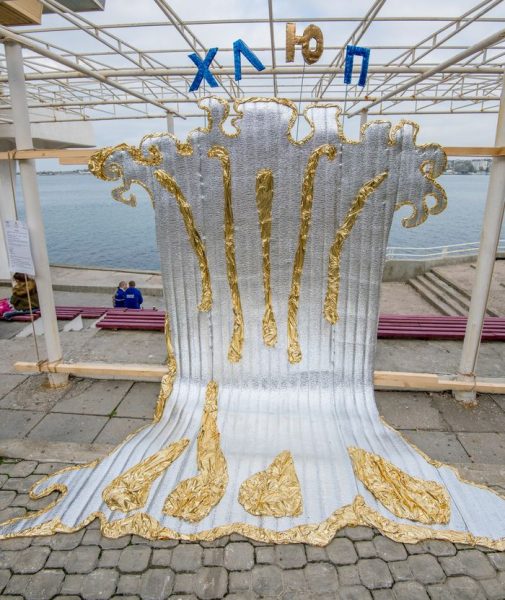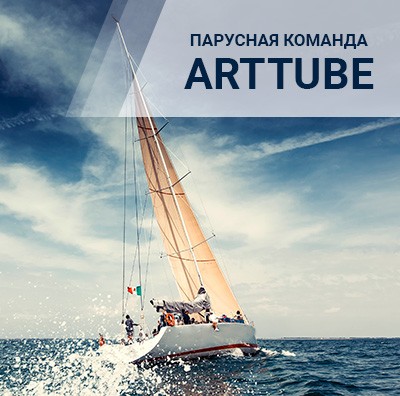In the framework of the Through the Waves project artists have created objects of modern art based on the theme of sailing
A solemn ceremony to award the Yachtsman of the Year 2018 Public Prize will take place in Moscow today, and Lera Kovalenko, ArtTube director and co-producer of the Through the Waves project, is among its nominees. The ArtTube team congratulates her and wishes her continued success. Meanwhile, the Through the Waves project, organized as part of the National Sailing League, has come to an end.
Launched in March of this year, it combined sport and modern art: the program of events was divided into six stages, during which in different cities Russian artists created objects somehow connected with sailing. For many of them it was the first experience of a kind, so we asked project participants to share their impressions.

Figure 1
Stage I – Sochi. Valery Kazas, “I had’t finished and left on what I had”. Photo by: Andrey Sheremetyev
Valery Kazas:
«This piece has a little story. A certain hypothetical character dreams of the sea. He builds himself a watercraft, while not having neither knowledge nor appropriate skills. He works hard, but when his friends call him to the sea, he drops everything and joins them. The design remains unfinished, with technical errors. One can say that my work is about desire and inability. All the errors I made on purpose, of course. I know how it should be, but my character does not. Interestingly, during my stay in Sochi my friends also called me to the sea, to take part in a sailing race, because one of the teams had not enough members. But I had to leave, besides, it’s not really my kind of sport. What I like about Through the Waves project is that this is a unique point where sport and modern art have crossed. In the West, there is a certain person named Jerry Judah, who creates huge sculptures on the eve of various events related to auto racing. Some hefty frame, with full-scale cars on top of it. I can’t remember any other artist who would act like that, in parallel with sporting events. And here, in Russia, we have no analogues at all. Of course, there are many monuments to baseball players, golfers, hockey players and others, lots of such things, but this has nothing to do with modern art. So this project is a good example. I myself would be interested to do something else related to sports».

Figure 2
Stage II – Sochi. Lyudmila Baronina, “Where the sun is a temporary guest.” Photo by: Andrey Sheremetyev
Lyudmila Baronina:
«I didn’t have a chance to engage in public art before taking part in this project. I made once a construction for the festival, also using a cloth, but it was something like a pavilion where master classes were held. I love working with mythology, finding it in everything, and here I wanted to focus on the history of the city of Sochi, saturated with mythological heritage. It was even more interesting to me, because I live in Krasnodar, so not far from Sochi. In my work, I appeal to the architectural heritage of Sochi, as if reviving monuments and imagining what would it be like if it really happened. This is sort of an attempt to look at the city with their eyes, because they are the most loyal observers and witnesses of history. I made the object itself in the form of a sail with a hole, which also refers to the Sail rock, also located on the Black Sea coast and incorporating numerous stories and myths. The starting point for my object creation was the urban sculptures and reliefs, it attracts all these stories like a magnet. During the installation, local residents constantly offered their help, which was very pleasant, and looked at the fabric with interest, recognizing various familiar sculptures from the parks in the images on it. New and interesting are integral parts when working on something like this, especially in another city. In just one day, the team and I assembled an object, surrounded by all the cats of Sochi, and even made an easel from the remaining materials. And then we even managed to go to an abandoned sanatorium named after Ordzhonikidze and then got to Abkhazia, but that’s another story».

Figure 3
Stage III – Konakovo. Marina Zvyagintsevа, “#CAMESAILINGIN.” Photo by: Andrey Sheremetyev
Marina Zvyagintsevа:
«For me, participation in this project was a surprise. Shortly before I was invited to it, I participated with my installation The Sea of a Bedroom Suburb in a similar project organized by ArtTube in Skolkovo. I thought it would be over back then, but suddenly Anya Zykina called me and said that I had to urgently bring something to Konakovo. Something did not work out with the artist who was invited before me, and the events were to begin in two weeks. I started to think, it seemed to me that I didn’t have anything that could suit thematically. And then I remembered about my object “#CAMESAILINGIN”, which fit in perfectly there. I didn’t expect my work to stay there for a whole season, but it aroused great interest. Apparently, this is due to its interactivity, you can climb into it, take pictures. I saw a lot of photos on Instagram with my object, but I especially remember the picture where one lady practicing yoga was standing on her head inside my boat. The object was made several years ago, it was exhibited more than once, managed to attend the Manor Jazz festival in Arkhangelsk, and traveled on the roof of the Kommersant FM mobile studio as part of the Night of Museums. So it already has some kind of its own story and it was interesting for me to continue it by sending it on such a trip around the country. It is always interesting when an object leaves Moscow, lives its own independent life. Like a child who went to the camp, and you sit and worry here for him. It is also important that my sculpture never stood by the water, and in Konakovo from some angles it seemed that it really floats like a boat. After all, when creating any object of public art, the environment in which it will be located plays an important role. Everything was perfect here. Then, however, my sculpture was copied and installed in a park in Shatura. Please note that the object was not copied at the Manor Jazz festival, didn’t copy in the park Sadovniki or anywhere else, and here suddenly such interest appeared. Of course, I didn’t really like the copying story, but it means that I hit the spot».

Figure 4.
IV – stage St. Petersburg. Ashot Babikin, “Signs of the Sea Soul”. Photo by: Andrey Sheremetyev
Ashot Babykin:
«I am a stay-at-home man, a man of comfort. I like things. I like their meanings, not only functional, but also symbolic. The ideal of art for me is the ready-made, art of existing things. I see the overproduction of symbols in modern culture, we have forgotten how to see simple truths in this flea market of new products. And my work is not meant to introduce new things and meanings, but to reveal existing ones. It is an ecological art in the best sense. Road signs are symbols, perhaps the most common and unequivocally accepted by all society groups. Therefore, I have been working with them for a long time. In 2016, I showed the Signs project in Vladivostok in the Garage 33 +1 Gallery. Then some objects from this series were included in the Union of Russian Artists project at the Triennale in the Garage in Moscow. For existing symbols to speak in a new way, it is enough to change them a bit and add a little absurdity. In this project, I especially like the fact that I don’t touch on production issues – the factory technology is so debugged and has passed the test of time, temperatures, vandals, that there is nothing to add here. I adjust the design a bit, the rest is done by the workers of the factory. In the Signs of the Sea Soul project I also worked with water signs. Seemingly regular road and water transport signs, made according to all the state and technical standards, but slightly distorted in part of the design, become illustrations of such a mysterious phenomenon as the sea soul. Passion for traveling across the boundless expanses, commitment to the male fraternity, love for one’s native Peter – the Baltic capital, courage and sailor enthusiasm – these are the themes that are revealed in art objects from this series. The names speak for themselves. “Footpath: sailors do not swim, but sail”, “Information: we are in striped vests”, “Embankment ahead: sailing away”, “Attention: sea soul!” and so on. I heard that the locals fully understood my messages as well as those who commented on my project on the Internet, and those who later bought these works at Cosmoscow. In this project, the experience of remote work was unique for me: I communicated with customers, curators, and manufacturers only in messengers. I did not see the objects themselves, I did not hold them in my hands. And it fully implements my ideals as an artist, distancing from production. It was a completely new experience».

Figure 5.
Stage V – Moscow. Alexander Zaitsev, “Untitled”, from the series “Silent Criticism”. Photo by: Oleg Semenyuk
Alexander Zaitsev:
«A funny story is connected with this project. When I first came to take pictures for my future work, I confused yacht clubs. There are two of them – an ordinary, sports one, and an “elite” one, where rich people spend their time. I headed to the second, where he was stopped by guards, big, bulky guys, as if from the 90s. Then I came up with a story, telling them that I was going to marry, and I wanted the wedding to be at this club. And asked them to show me the territory. The camera was explained by the fact that my bride was very worried about future wedding photos, so I had to make sure that the background was beautiful. They believed me and let me in. After wandering around this yacht club I realized my mistake, of course. But I returned there a few more times afterwards to make suitable photos. I was interested in the lake view, because people from the yacht club see it all the time, it is familiar to them. And I wanted to play around with it. I have long been working with the language of ideograms and emoticons, popular on the Internet. I like to change their format, embed them in painting, in photography and other mediums. With their help, you can, for example, create political or social criticism, but you can do it without judging as well. Then “stupidity”, idiocy, and even something completely uncharacteristic starts showing itself in some ordinary things. In this case, emojis are changing the view of the lake beyond recognition. It turned out pretty fun, I think. I had previously thought about this kind of work with space and with a site-specific environment, and here I had a real opportunity to experiment. So for me this project is, first of all, a very interesting experience».

Figure 6.
Stage V – Vladivostok. Kirill Kryuchkov, “Friendship. Teamwork”. Photo by: Igor Bessarab
Kirill Kryuchkov:
«The object was created specifically for this project. It’s a new experience for me, I don’t often implement an idea in the material. I decided not to depart from my usual style, so I created an almost two-dimensional installation. The object was made of plywood and timber, painted with acrylic paint. I collected the composition by layers. In addition to the tree, there is also a figured relief of putty on the waves, but this can only be seen live upon close examination. I think that many liked the plot. Interesting colors, styling forms. I admit that some people might not agree, but in my opinion the project was a success. I want to thank Anya Zykina, the most wonderful curator, for her patience and support. It was interesting for me to participate in such a project. In Vladivostok, where I live, there is a yacht club and, most importantly, people who are passionate about this sport. So the waves, the hills, have long been entrenched in the plots of my structural compositions in the artistic painting of walls».

Figure 7
Stage VI – Sevastopol. Alina Glazun, «Splash». Photo by: Andrey Sheremetyev
Alina Glazun:
«I’m very glad to be invited by ArtTube. I have long had a desire to move in the direction of public art projects. One can’t say that this is my first experience in the open air: for example, in the summer, at the Forma festival, I also showed an open air installation, but it was an arts festival, and here the situation and tasks are completely different. First, it was necessary to take into account the specifics of the event and the audience. Yacht racing is very beautiful, but it is a festival of sports, not art, people do not go there to watch art and reflect on it. Therefore, it was necessary to offer something simple, concise, visually intense, funny, something making you want to take a picture with. This is how the image of a radiant wave with “Splash” written on it appeared. Such a silver and gold decoration for the Neptune holiday the Soviet sanatorium. Secondly, it was necessary to take into account the specifics of the place. The “wave” was supposed to be installed on the territory of the CSKA Navy, and we were faced with a huge number of restrictions: it cannot be placed there, it cannot be set too high, it cannot be deployed in this way, it cannot be attached. I really wanted to choose a point so that so that you can see the sea behind the object, to preserve the “site-specific” character of the work. And with more or less success, the brilliant wave found its place against the backdrop of the sea. As for the image of my installation, the source of inspiration was the myth, an episode from Hesiod’s Theogony, which tells how Kronos emasculates Uranus, cut off penis fell into the water (that’s where the sound of splash comes from), foam was formed, and beautiful Aphrodite came out of that foam. Of course, we told this story only to the most sophisticated spectators, the rest were told that the squish is the sound associated with water in all its manifestations. A splash under our feet, a splash from a tap, splash from dripping nose, a splash when diving into the sea. Local children quickly chose a brilliant sculpture. One little boy was photographed and shouted loudly: “I am a splash, I am a splash!” Well, as always in my art, exactly as in my life, kitties had to be involved in it somehow: they were both the first audience and the first helpers. A large number of cats living on the embankment rushed to master my wave with great enthusiasm: they played with silver lumps, traveled in them, and when the wave was ready, they immediately sat down to rest there. The next day, there were already visible traces of claws and other feline activities, but this not only did not spoil the installation, but on the contrary added life to it».
Prepared by Evgenia Zubchenko


